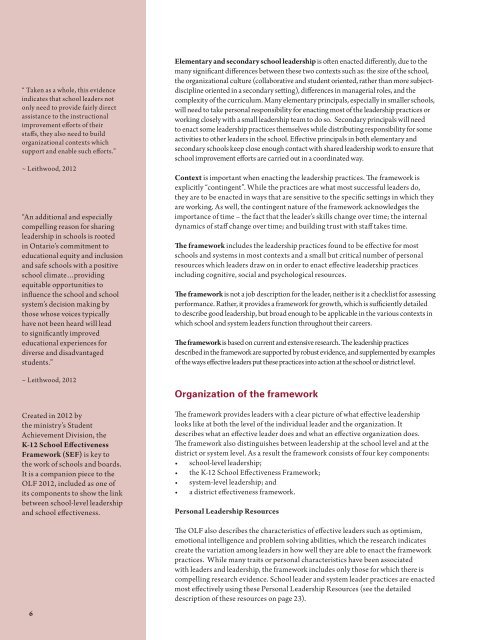The Ontario Leadership Framework 2012
THE ONTARIO LEADERSHIP FRAMEWORK 2012 - EduGAINS
THE ONTARIO LEADERSHIP FRAMEWORK 2012 - EduGAINS
Create successful ePaper yourself
Turn your PDF publications into a flip-book with our unique Google optimized e-Paper software.
“ Taken as a whole, this evidenceindicates that school leaders notonly need to provide fairly directassistance to the instructionalimprovement efforts of theirstaffs, they also need to buildorganizational contexts whichsupport and enable such efforts.”~ Leithwood, <strong>2012</strong>“An additional and especiallycompelling reason for sharingleadership in schools is rootedin <strong>Ontario</strong>’s commitment toeducational equity and inclusionand safe schools with a positiveschool climate…providingequitable opportunities toinfluence the school and schoolsystem’s decision making bythose whose voices typicallyhave not been heard will leadto significantly improvededucational experiences fordiverse and disadvantagedstudents.”~ Leithwood, <strong>2012</strong>Created in <strong>2012</strong> bythe ministry’s StudentAchievement Division, theK-12 School Effectiveness<strong>Framework</strong> (SEF) is key tothe work of schools and boards.It is a companion piece to theOLF <strong>2012</strong>, included as one ofits components to show the linkbetween school-level leadershipand school effectiveness.Elementary and secondary school leadership is often enacted differently, due to themany significant differences between these two contexts such as: the size of the school,the organizational culture (collaborative and student oriented, rather than more subjectdisciplineoriented in a secondary setting), differences in managerial roles, and thecomplexity of the curriculum. Many elementary principals, especially in smaller schools,will need to take personal responsibility for enacting most of the leadership practices orworking closely with a small leadership team to do so. Secondary principals will needto enact some leadership practices themselves while distributing responsibility for someactivities to other leaders in the school. Effective principals in both elementary andsecondary schools keep close enough contact with shared leadership work to ensure thatschool improvement efforts are carried out in a coordinated way.Context is important when enacting the leadership practices. <strong>The</strong> framework isexplicitly “contingent”. While the practices are what most successful leaders do,they are to be enacted in ways that are sensitive to the specific settings in which theyare working. As well, the contingent nature of the framework acknowledges theimportance of time – the fact that the leader’s skills change over time; the internaldynamics of staff change over time; and building trust with staff takes time.<strong>The</strong> framework includes the leadership practices found to be effective for mostschools and systems in most contexts and a small but critical number of personalresources which leaders draw on in order to enact effective leadership practicesincluding cognitive, social and psychological resources.<strong>The</strong> framework is not a job description for the leader, neither is it a checklist for assessingperformance. Rather, it provides a framework for growth, which is sufficiently detailedto describe good leadership, but broad enough to be applicable in the various contexts inwhich school and system leaders function throughout their careers.<strong>The</strong> framework is based on current and extensive research. <strong>The</strong> leadership practicesdescribed in the framework are supported by robust evidence, and supplemented by examplesof the ways effective leaders put these practices into action at the school or district level.Organization of the framework<strong>The</strong> framework provides leaders with a clear picture of what effective leadershiplooks like at both the level of the individual leader and the organization. Itdescribes what an effective leader does and what an effective organization does.<strong>The</strong> framework also distinguishes between leadership at the school level and at thedistrict or system level. As a result the framework consists of four key components:• school-level leadership;• the K-12 School Effectiveness <strong>Framework</strong>;• system-level leadership; and• a district effectiveness framework.Personal <strong>Leadership</strong> Resources<strong>The</strong> OLF also describes the characteristics of effective leaders such as optimism,emotional intelligence and problem solving abilities, which the research indicatescreate the variation among leaders in how well they are able to enact the frameworkpractices. While many traits or personal characteristics have been associatedwith leaders and leadership, the framework includes only those for which there iscompelling research evidence. School leader and system leader practices are enactedmost effectively using these Personal <strong>Leadership</strong> Resources (see the detaileddescription of these resources on page 23).6
















